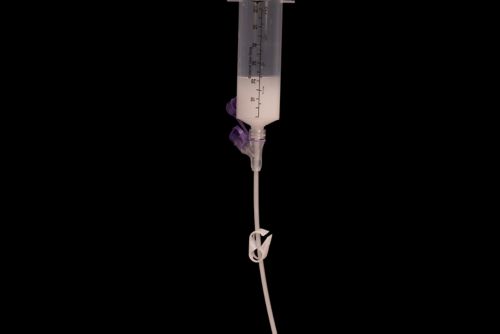Menu
Close
Back
Welcome to
Together is a new resource for anyone affected by pediatric cancer - patients and their parents, family members, and friends.
Learn MoreBolus feeding is a way to give enteral nutrition (tube feeding). Bolus feedings give large doses of formula several times a day. The formula is poured slowly into a syringe attached to a feeding tube or button.
Your care team will decide on best way to give your child tube feedings. Other ways to give tube feedings include continuous feeding and gravity feeding.
Always follow the instructions given by your care team.
Your care team will choose the best formula for your child’s nutritional needs.
Most formula comes ready to feed. It is in a can that you open and pour directly into a measuring container or a formula bag that goes with your child’s feeding tube. Some formula comes in a powder or liquid concentrate you mix with water. Your care team will tell you how to mix the formula, if needed.
Formula that has been opened or mixed can be stored in the refrigerator for 24 hours. Throw away any unused formula after 24 hours.
Your dietitian will tell you how much and how often to give the formula. You will need to know:
The formula should be at room temperature. If you keep it in the refrigerator, take it out about 1 hour before feeding time. Pour enough formula for 1 feeding into a clean container. Cover it and let it warm up to room temperature on the counter. Put any extra formula back in the refrigerator. Throw out any canned or mixed formula that has been open more than 24 hours.
Supplies for bolus feedings include:
The first time you attach the adapter it might be tight and hard to push in, and it may be uncomfortable for your child. However, it should not hurt after the skin has healed completely.
Make sure your child is sitting up for feedings so that their head is higher than their stomach. You can hold a small child on your lap or have them sit in a highchair. If your child is older, have them sit in a chair or highchair or raise the head of the bed 30–45 degrees. You can put pillows behind your child’s head to help them sit up in bed.

A formula filled syringe connected to an unclamped feeding tube
Keep your child's head higher than their stomach for 1 hour after the feeding.
Watch your child for any signs of nausea, vomiting, stomach swelling, pain, or being irritable (cranky or fussy) during the feeding and right after. If any of these things happen, stop the feeding, and call your care team.
Talk to your care team if you have any questions about tube feedings.
—
Reviewed: September 2022